Discover 5 hidden attractions, cool sights, and unusual things to do in Volcanoes National Park (Rwanda). Don't miss out on these must-see attractions: Mount Gahinga, Mount Karisimbi, and Mount Sabyinyo. Also, be sure to include Karisoke Research Center in your itinerary.
Below, you can find the list of the most amazing places you should visit in Volcanoes National Park (Amajyaruguru).
Table of Contents
Mount Gahinga
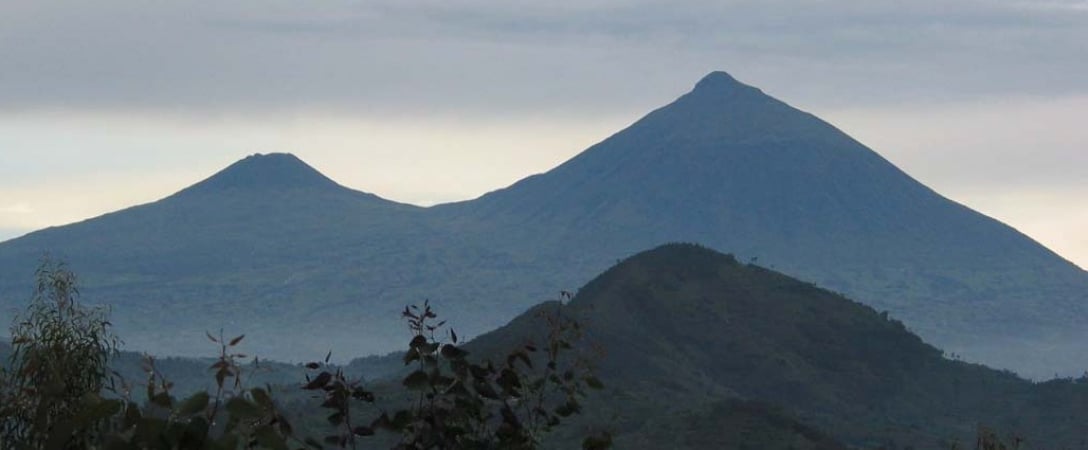
Also known as: Ikirunga cya Gahinga
Volcano in Rwanda. Mount Gahinga is a dormant/extinct volcano in the Virunga Mountains on the border between Rwanda and Uganda. Gahinga lies between Muhabura and Sabyinyo, but is the smallest of these three. Mount Gahinga, also known in the local Kinyarwanda/Rufumbira dialect as "a small pile of stones", has a swampy caldera on its peak. The caldera is believed to be about 180 m wide. Mgahinga Gorilla National Park also got its name from this volcano. Mount Gahinga, whose elevation is 3,473 m, is part of a chain of eight volcanic mountains of the Mufumbiro ranges. The volcano chain spans across Uganda, Rwanda and the Democratic Republic of Congo.
The vegetation across the mountain can be described as afro-montane with bamboo composing the main vegetation. Like Muhabura and Sabyinyo, the bamboo forests on Mount Gahinga are a habitat of the endangered mountain gorilla. There are several other species of animals and birds that form part of the Mount Gahinga ecosystem. The golden monkeys are notable to these.[1]
Mount Karisimbi
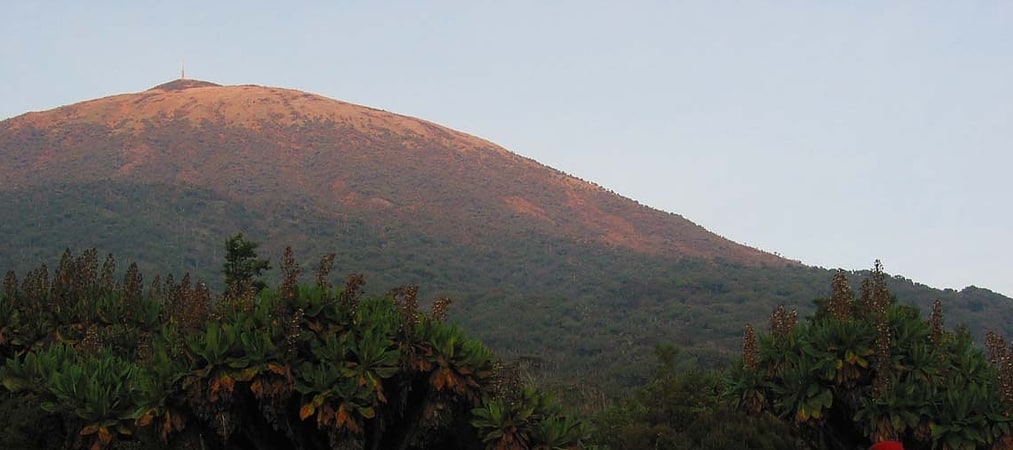
Also known as: Ikirunga cya Karisimbi
Stratovolcano in Rwanda. Mount Karisimbi is a stratovolcano in the Virunga Mountains on the border between Rwanda and the Democratic Republic of Congo. It is currently dormant. At 4,507 metres, Karisimbi is the highest of the eight major mountains of the mountain range, which is a part of Albertine Rift, the western branch of the East African Rift. Karisimbi is flanked by Mikeno to the north, Bisoke to the east and Nyiragongo to the west, on the other side of the Rift Valley. Karisimbi is the 11th highest mountain of Africa.
The name Karisimbi comes from the word 'amasimbi' in the local language, Kinyarwanda, which means snow. Snow can mostly be found during the dry season in June, July and August on the top of the volcano.
Between Karisimbi and Bisoke is the Karisoke Research Center, which was founded by Dian Fossey in order to observe the mountain gorillas living in this area.[2]
Mount Sabyinyo
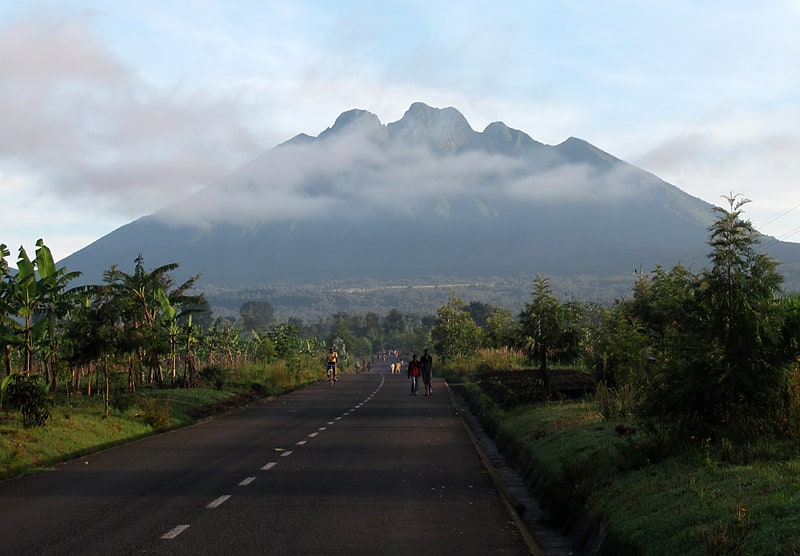
Extinct volcano in the Democratic Republic of the Congo. Mount Sabyinyo is an extinct volcano in eastern Africa in the Virunga Mountains. Mount Sabyinyo is the oldest volcano of the range. It is north-east of Lake Kivu, one of the African Great Lakes, and west of Lake Bunyonyi in Uganda. The summit of the mountain, at 3,669 metres, marks the intersection of the borders of the Democratic Republic of the Congo, Rwanda, and Uganda, and holds religious significance to local tribes. It also is within the adjoining national parks established by these countries: Virunga National Park in the DRC, the Volcanoes National Park in Rwanda, and Mgahinga Gorilla National Park in Uganda.
The slopes of Mt. Sabyinyo are a habitat for the critically endangered mountain gorilla. The mountain carries the local nickname "Old Man's Teeth," because its serrated summit resembles worn teeth in a gum line (in contrast to the perfect conical summits of the adjacent mountains in this range).[3]
Karisoke Research Center
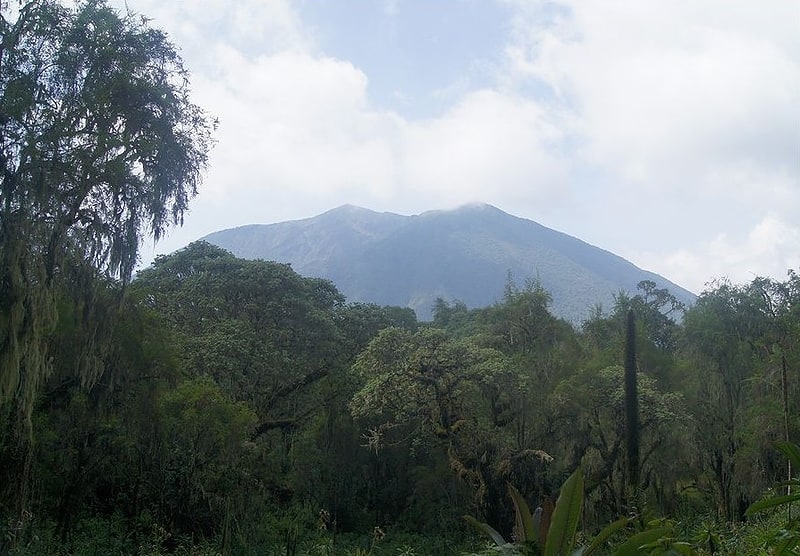
Research institute. The Karisoke Research Center is a research institute in Rwanda's Volcanoes National Park. It was founded by Dian Fossey on 24 September 1967 to study endangered mountain gorillas. Fossey located the camp in Rwanda's Virunga volcanic mountain range, between Mount Karisimbi and Mount Bisoke, and named it by combining the names of the two mountains.
After Fossey's murder in December 1985, the camp continued to function under the auspices of the Dian Fossey Gorilla Fund International. In 2012, Karisoke moved its headquarters to a more modern facility in Musanze.
At the time Fossey founded Karisoke, she feared that the mountain gorilla might become extinct by the end of the 20th century, as her mentor, Dr. Louis Leakey, had warned. A census published in 1981 found that the population had fallen to 242 individuals, from a 1960 estimate of 400–500. As of 2010, 45 years later, some 480 mountain gorillas are known to inhabit the Virunga mountains, a significant increase. Karisoke survived Fossey's murder in 1985 as well as years of civil strife and also expanded tremendously over the past few decades.[4]
Mount Sabinyo
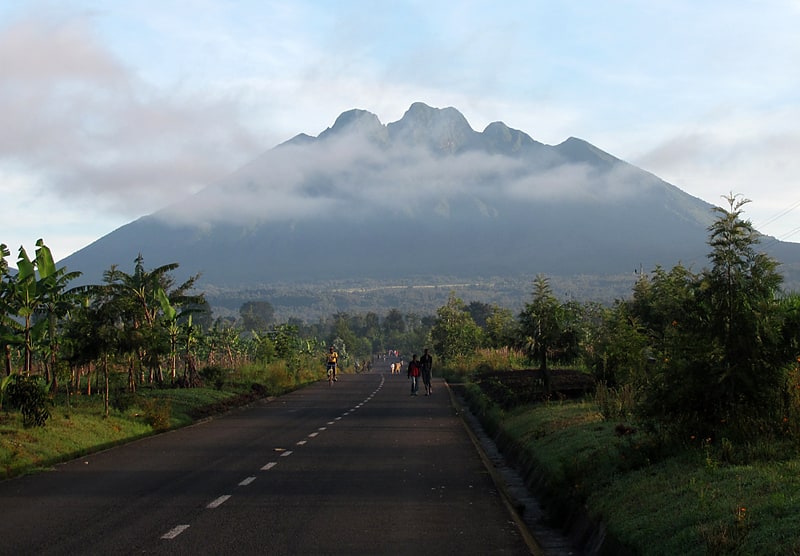
Also known as: Ikirunga cya Sabyinyo
Extinct volcano in the Democratic Republic of the Congo. Mount Sabyinyo is an extinct volcano in eastern Africa in the Virunga Mountains. Mount Sabyinyo is the oldest volcano of the range. It is north-east of Lake Kivu, one of the African Great Lakes, and west of Lake Bunyonyi in Uganda. The summit of the mountain, at 3,669 metres, marks the intersection of the borders of the Democratic Republic of the Congo, Rwanda, and Uganda, and holds religious significance to local tribes. It also is within the adjoining national parks established by these countries: Virunga National Park in the DRC, the Volcanoes National Park in Rwanda, and Mgahinga Gorilla National Park in Uganda.
The slopes of Mt. Sabyinyo are a habitat for the critically endangered mountain gorilla. The mountain carries the local nickname "Old Man's Teeth," because its serrated summit resembles worn teeth in a gum line (in contrast to the perfect conical summits of the adjacent mountains in this range).[5]